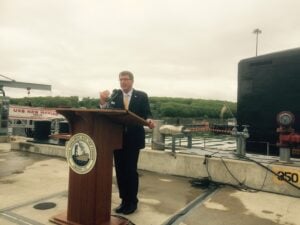Naval Today said:Having completed its second scheduled deployment to the Western Pacific, U.S. Navy’s Virginia-class fast-attack submarine USS Texas (SSN 775) returned to Joint Base Pearl Harbor-Hickam, March 9.
During deployment, the boat steamed over 27,000 miles and conducted four port-call visits in two foreign countries while conducting missions.
Cmdr. Todd Nethercott, commanding officer of USS Texas, said:
“The ship and crew performed exceedingly well. Few Sailors aboard two years ago could even fathom that Texas would be pulling in today after having completed a highly successful Western Pacific deployment.”
USS Texas had been in dry dock for 26 months before she deployed, which made guidance from senior crew members crucial.
Master Chief Machinist’s Mate Daniel Kloepfer, chief of the boat aboard USS Texas, said:
“There is nothing better than taking a shipyard crew and training them into sharp, proficient, steely-eyed killers of the deep. While the first-term sailors brought an abundance of energy and enthusiasm to the boat, the seasoned Sailors brought the experience and the knowledge necessary to change Texas from a ship into a warship.”
During their deployment, 11 Sailors and three officers earned their submarine warfare qualifications and now wear the submarine warfare insignia, or dolphins. Additionally, 11 Sailors were advanced in rank.
A number of objectives were accomplished during the submarine’s deployment, including participation in two exercises with the air, surface and subsurface components of the Japan Maritime Self-Defense Force.
USS Texas set a new submerged endurance record for the ship while conducting missions vital to national security. Also, the culinary team was recognized as one of four finalists for the Captain Edward F. Ney award for culinary excellence.
Commissioned September 9, 2006, USS Texas is the second of the Navy’s Virginia-class fast-attack submarines and the fourth warship to be named after the U.S. state of Texas. Measuring 377 feet (115m) long and weighing more than 7,900 tons, the submarine is capable of executing anti-submarine warfare, anti-surface ship warfare, and shallow water operations.
USS Texas was the 2nd Virginia Class submarine launched and commissioned. Now nine and a half years ago. (hard to believe).
interesting that on this deployment she sailed 27,000 miles. A testimony to the benefits of nuclear powered attack submarines.


